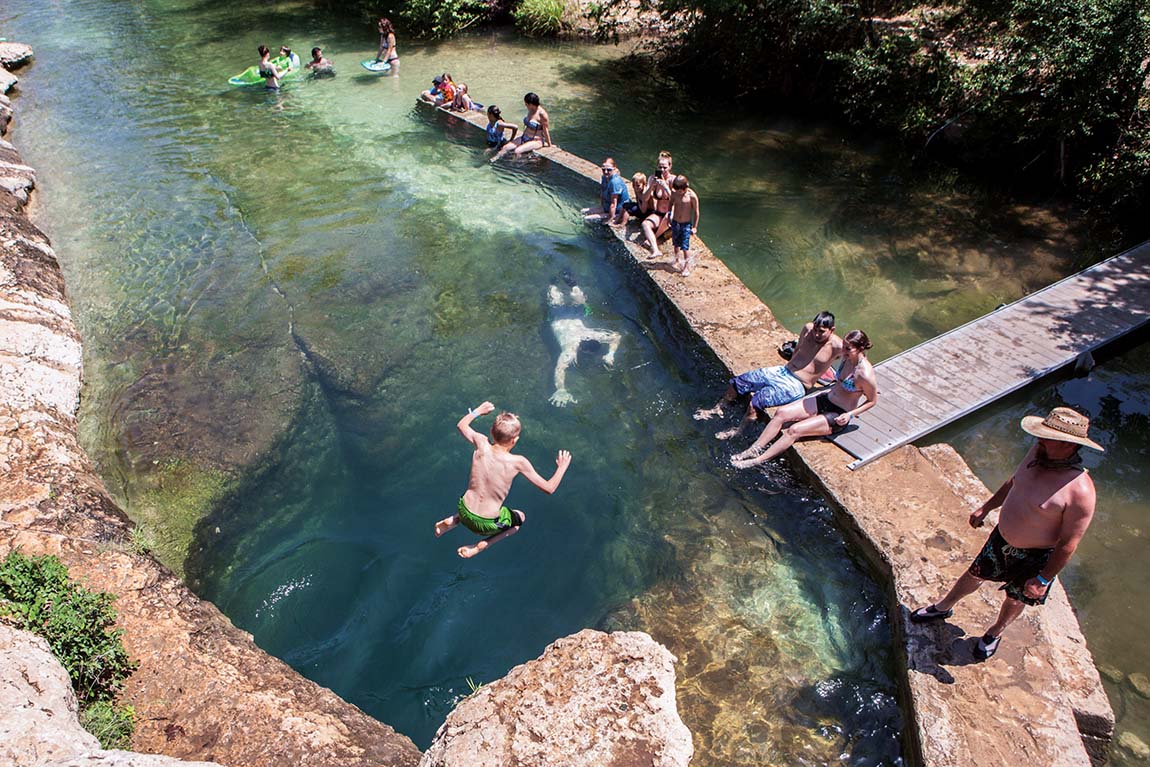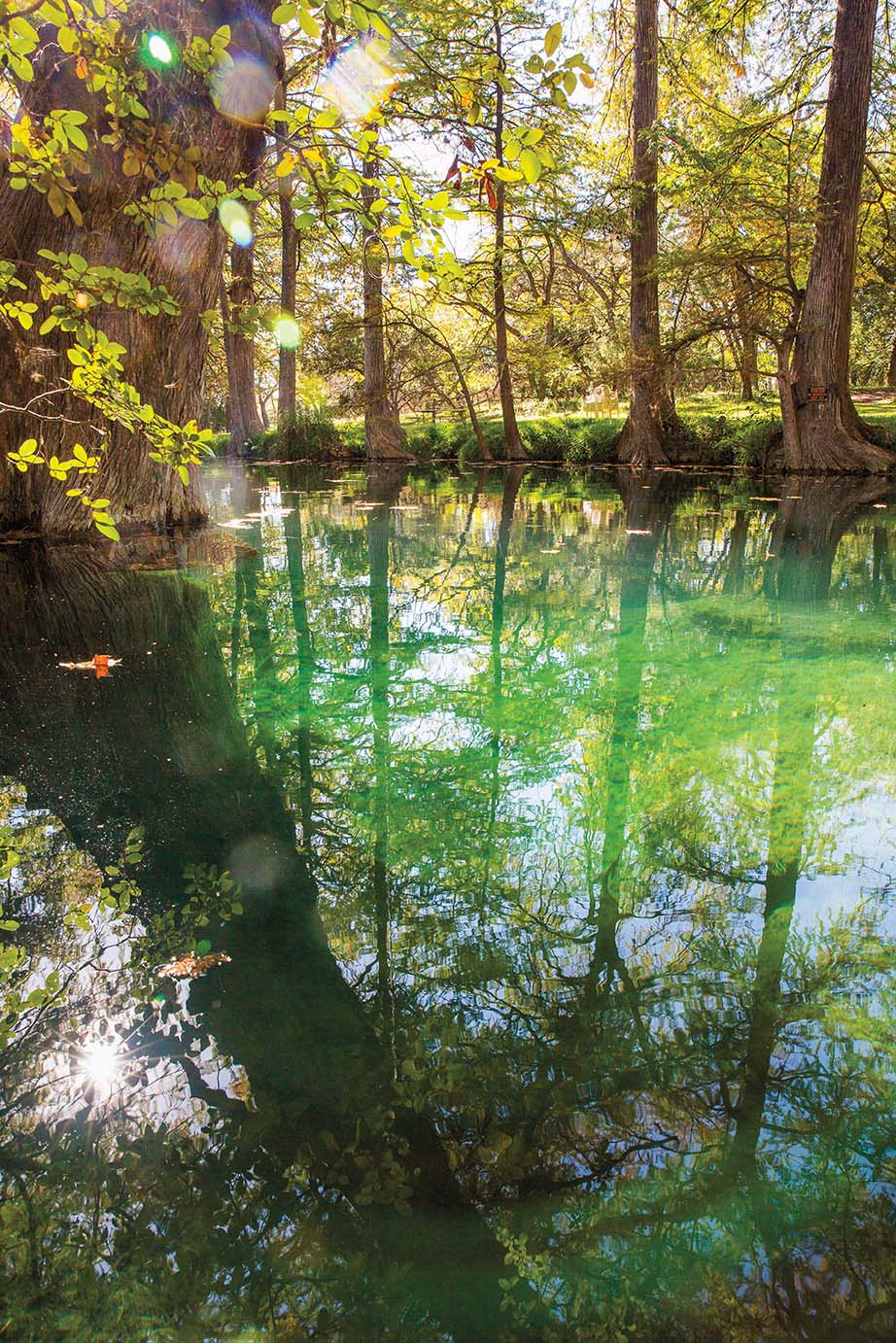
I look down upon the blue-and-green-tinted waters of Jacob’s Well, the headwaters of Cypress Creek. Even barely full on this spring morning, the storied swimming hole remains enchanting. “See how it changes with the light?” muses Katherine Sturdivant, education coordinator for Jacob’s Well Natural Area.
In the receding shadows, Jacob’s Well reveals itself like an awakening eye. The dark, mirror-like surface transforms into a crystalline stone tunnel. A school of colorful sunfish and a slender Guadalupe bass circle the rim of the pool, “basically trapped in here,” Sturdivant says, due to lack of water flow. I gaze 23 feet to the pebbly edge of the Well’s floor, toward the narrow entrance of the cave that leads into the depths of the Middle Trinity Aquifer.
Increasingly, here in the over-loved and under-protected Wimberley Valley, this spring seems destined to disappear. Since 2000, Jacob’s Well has ceased flowing four times, most recently in the oppressively hot summer of 2022. Sturdivant puts that in perspective, explaining how even during Texas’ drought of record, from 1949 to 1957, when half the state’s farms went fallow, “Jacob’s Well never stopped flowing.”
The drying of Jacob’s Well feels profound. Beyond Wimberley, other waters that have cooled generations of Texans also gave in to the latest drought. In 2022, officials urged visitors at Dinosaur Valley State Park in Glen Rose to avoid the gunky Paluxy River. The limestone pool at Tonkawa Falls City Park in Crawford never opened. And Brackettville’s Fort Clark Springs, the state’s third-largest spring-fed pool, closed due to lack of water flow.
The Wimberley Valley Watershed Association, an advocacy organization for Jacob’s Well, has the mission of keeping the spring and Cypress Creek clean, clear, and flowing for generations to come. In 2021, the Wimberley Valley Watershed purchased 248 acres upstream of Jacob’s Well, bringing its preservation space in the recharge zone above the Middle Trinity Aquifer to 350 total acres. But without further protective measures, the long-term fate of Jacob’s Well—and swimming holes across the state—remains in doubt.
In the years following its 1850s discovery by a group of Hill Country settlers, Jacob’s Well has attracted scores of thrill-seeking Texans. They’ve leapt from the cliffs into the chilly water and swam into the cave as far as their breath would hold, and beyond: Between 1964 and 1984, nine people drowned diving in Jacob’s Well. Today, only members of the Jacob’s Well Exploration Project can scuba dive in the cave.
The JWEP team performs important work, mapping the subterranean channels of Jacob’s Well to better understand how the water that falls from the sky eventually reemerges here, forming Cypress Creek. This tree-lined tributary of the Blanco River flows through the Wimberley square, providing a scenic backdrop for the cafés, shops, and rental homes that drive the area’s tourism industry. Cypress Creek also serves as a source of recreation and relaxation. Downstream from Jacob’sWell at Cypress Falls, you can float with a beer while enjoying live music. At Wimberley’s Blue Hole Regional Park, you can soar into the water from a rope swing or lounge beneath the shade of an ancient cypress tree.


But it’s exactly this paradise, and all who come here to enjoy it, that’s strain-ing Jacob’s Well. “The problem is population growth, plus drought,” says Linda Kaye Rogers, the board president of the Hays Trinity Groundwater Conservation District. “It’s killing Wimberley.” Rogers, an elected official who doesn’t draw a salary, oversees groundwater usage in western Hays County, which spans from Wimberley to Dripping Springs. She explains how nearly every ounce of water used in her district, from lawn watering to concrete plants, is pumped from the source of Jacob’s Well, the Middle Trinity Aquifer.
As we talk, she’s at the Texas Capitol to testify on bills that strengthen groundwater conservation. Many of our state’s efforts to manage the water beneath our feet are relatively nascent. The HTGCD was formed in 2001, and Rogers says much of the District’s regulatory power remains patchwork and ostensibly contradictory. For private well owners, the historic “rule of capture” still applies. This means property owners can legally draw as much as 25,000 gallons of water a day from the Middle Trinity Aquifer for personal use, with little to no oversight. Additionally, Rogers says, “we’re the only groundwater district in the state funded by connection fees,” charges for hooking up new homes and businesses to the aquifer. “We’re funded by growth,” she says.
Rogers sees public education on groundwater issues, water conservation, and preservation of the open spaces that help recharge the Middle Trinity Aquifer as key to preserving springs like Jacob’s Well. At least two local business owners, Kent and Karen Killough of Vista Brewing in Driftwood, hope groundwater districts like the HTGCD gain more regulatory authority. Currently, the HTGCD can fine commercial water users who exceed their permitted allotment. “But the fees aren’t very large,” Kent says. “The current barrier is insufficient to control usage.”With their business, the Killoughs have sought to lead by example. While it takes about seven pints of water on average to produce one pint of beer, Kent says efficiencies in Vista Brewing’s processes have reduced what they pull from the Middle Trinity Aquifer by about 30%, all while preserving local terroir for the brewery’s future.
This isn’t the first time a beloved Texas swimming hole has faced the threat of demise. In the early 1990s, a proposed development with three golf courses threatened the Edwards Aquifer, which recharges Austin’s Barton Springs Pool. “But that spring was saved almost entirely out of love,” says Robert Mace, the executive director of The Meadows Center for Water and the Environment at Texas State University. Residents showed up en masse at City Hall to support Barton Springs, leading to the formation of the advocacy group Save Our Springs. Later, Mace says, the discovery of an endangered species, the Barton Springs salamander, provided a more lasting protection from the abuse and overuse of the Edwards Aquifer.
Sturdivant recalls with some amusement the time a neighborhood boy who’d been swimming in Jacob’s Well ran up to the park ranger’s office. He claimed to have seen bioluminescent flowers peeking from the cave entrance. The staff raced down to the spring, hoping to have found their own endangered species. Instead, they found the neon light was coming from plastic glow sticks left there by late-night swimmers.
Make a Splash
Go where the water’s still flowing
Balmorhea State Park
The spring-fed oasis sits at the edge of the Davis Mountains. Reservations are recommended for day passes. tpwd.texas.gov
Shaffer Bend Recreation Area
This Lower Colorado River Authority park offers a sandy shoreline for swimming just downstream from Marble Falls. lcra.org
Lake Mineral Wells State Park
Splash at the beach or rent kayaks, canoes, and paddle boards from the park store. tpwd.texas.gov
Daingerfield State Park
Constructed in the 1930s by the Civilian Conservation Corps, this Piney Woods lake features a floating swim platform 30 yards off-shore. tpwd.texas.gov
South Llano River State Park
The Llano River where it flows through Junction has yet to run dry in recorded history. tpwd.texas.gov
As we look down at the Well and the colorful fish trapped inside, I ask Sturdivant, “Is there some silver lining, a ray of optimism I could end this story with?” She doesn’t hesitate.
“People still come here to experience the beauty of Jacob’s Well, even if they can’t currently swim here,” she tells me. They see the spring on life support. They became educated on the factors that impact our groundwater. And, hopefully, they act. “It’s not gone yet,” she says.








